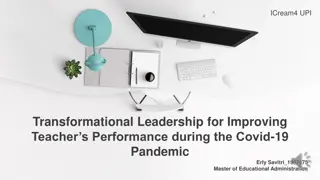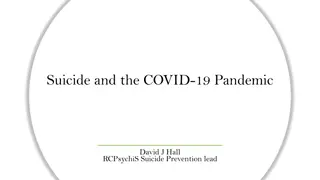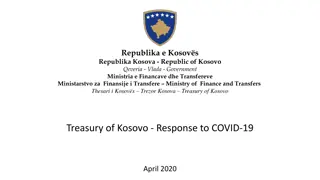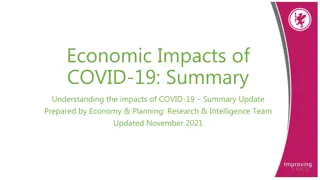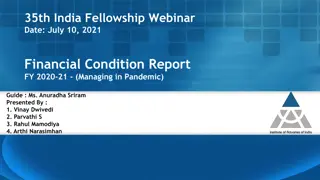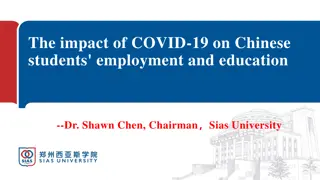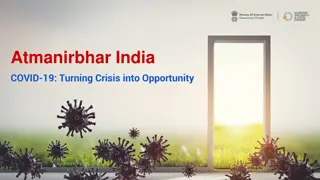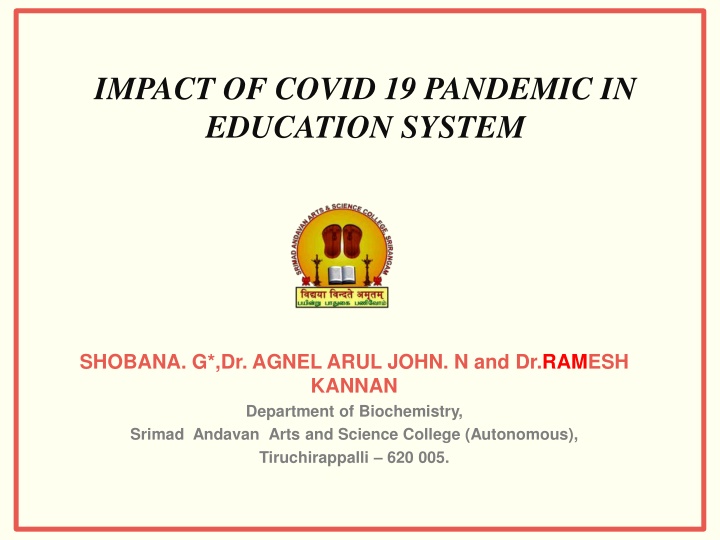
Impact of COVID-19 Pandemic on Education System in India
The COVID-19 pandemic has significantly disrupted the education system in India, leading to closures of educational institutions and a shift towards online learning. This study analyzes the various impacts, government initiatives, technologies used, and UNESCO recommendations in response to the crisis.
Download Presentation

Please find below an Image/Link to download the presentation.
The content on the website is provided AS IS for your information and personal use only. It may not be sold, licensed, or shared on other websites without obtaining consent from the author. If you encounter any issues during the download, it is possible that the publisher has removed the file from their server.
You are allowed to download the files provided on this website for personal or commercial use, subject to the condition that they are used lawfully. All files are the property of their respective owners.
The content on the website is provided AS IS for your information and personal use only. It may not be sold, licensed, or shared on other websites without obtaining consent from the author.
E N D
Presentation Transcript
IMPACT OF COVID 19 PANDEMIC IN EDUCATION SYSTEM SHOBANA. G*,Dr. AGNEL ARUL JOHN. N and Dr.RAMESH KANNAN Department of Biochemistry, Srimad Andavan Arts and Science College (Autonomous), Tiruchirappalli 620 005.
Introduction Corona virus disease is a communicable disease caused by a newly detected corona virus.Almost the people of every state in India are threatened due to the speedy spread of dangerous disease namely corona virus which is life challenging. To prevent and eradicate the darkness caused by the COVID-19, the Government of India has taken number of preventive measures including the closure of all Educational institutions followed by one day nationwide Janta-curfew to combat virus and 21 days lockdown to curb the corona virus, etc. Showing the great concern towards students, teachers and other stakeholders many circulars/ notices/ letters were issued by the relevant authoritative governing bodies like MHRD, UGC, CBSE, etc. On the other hand, the lockdown period has caused some severe issues also such as breakdown in regular lectures, postponement of exams, etc. which might cause the shortage of time during the next upcoming academic year. 2
The lockdown has compelled many educational institutions to cancel their classes, examinations, internships etc. and to choose the online modes. Initially, the educators and the students were quite confused and didn t understand how to cope up with the situation of this sudden crisis that compelled closure of the educational activities. COVID created many challenges and opportunities for the educational institutes to strengthen their infrastructure.The lockdown has given them a ray of hope for teachers and students to continue their educational activities through online. The teachers assigned work to students via internet, delivered lectures video conferencing using different Apps like Zoom, Google meet, Facebook, Youtube, and Skype etc. 3
Aim of the Study The present study was carried out to analyse the impact of covid 19 pandemic on education system in india. Objectives: Measures taken by the government during covid 19 pandemic on education system Positive and negative impacts Technologies used in education sector Response to crisis-UNESCO recommendations for learning made in ten engaging online
INITIATIVES OF GOVERNMENT ON EDUCATION DURING COVI 19 PANDEMIC Online learning is the best solution during this pandemic Covid-19 situation. So, the digital India vision of the government is emerging as a vital tool for solving the present crisis due to Covid-19. It is a fact that technology-based education is more transparent with all respect. Looking at this challenge of colleges and schools being shut, government of India, as well as state governments and private players have undertaken proper initiatives. The Ministry of Human Resource Development (MHRD) has made several arrangements, including online portals and educational channels through Direct to Home TV, Radios for students to continue learning. During lockdown, students are using popular social media tools like WhatsApp, Zoom, Google meet, Telegram, Youtube live, Facebook live etc. for online teaching learning system.ICT initiative of MHRD (e-Broucher- https://mhrd.gov.in/ict-initiatives ) is a unique platform which combines all digital resources for online education.
The digital initiatives of MHRD for secondary as well as higher education during COVID-19 1.Dikshaportal contains e-Learning content for students, teachers, and parents aligned to the curriculum,including video lessons, worksheets, textbooks and assessments. Under the guidance of its national boards of education (CBSE) and NCERT, the content has been created by more than 250 teachers who teach in multiple languages. The app is available to use offline. It has more than 80,000 e-Books for classes 1 to 12 created by CBSE, NCERT in multiple languages. The contents can also be viewed through QR codes on textbooks. The app can be downloaded from IOS and Google Play Store. Website: https://diksha.qov.in or https://seshaqun.qov.in/shaqun. 2.e-Pathshalais an e-Learning app by NCERT for classes 1 to 12 in multiple languages. The app houses books, videos, audio, etc. aimed at students, educators and parents in multiple languages including Hindi, Urdu, and English. In this web portal NCERT has deployed 1886 audios, 2000 videos, 696 e-Books and 504 Flip Books for classes 1 to 12 in different languages. Mobile Apps is available. Website: http://epathshala.nic.in or http://epathshala.qov.in.
3.National Repository of Open Educational Resources (NROER)portal provides a host of resources for students and teachers in multiple languages including books, interactive modules and videos including a host of STEM-based games. Content is mapped to the curriculum for classes 1-12, including aligned resources for teachers. It has a total of 14527 files including 401 collections, 2779 documents, 1345 interactive, 1664 audios, 2586 images and 6153 videos on different languages. Website: http://nroer.qov.in/welcome 4.Swayamis the national online education platform hosting 1900 courses covering both school (classes 9 to 12) and higher education (under graduate, post graduate programs) in all subjects including engineering, humanities and social sciences, law and management courses. The unique feature is that, it is integrated with 12583 Pravat Kumar Jena, Impact of pandemic covid-19 on education in India the conventional education. Credit transfers are possible for SWAYAM courses (max. 20%). Website: https://swayam.gov.in/ . 7
5.Swayam Prabhahas 32 DTH TV channels transmitting educational contents on 24 x 7 basis. These channels are available for viewing all across the country using DD Free Dish Set Top Box and Antenna. The channel schedule and other details are available in the portal. The channels cover both school education (classes 9 to 12) and higher education (undergraduate, postgraduate, engineering Out-of-school children, vocational courses and teacher training) in arts, science, commerce, performing arts, social sciences and humanities subjects, engineering, technology, law, medicine, agriculture. Website: https://swayamprabha.gov.in/ . 6.e-PG Pathshala is for postgraduate students.Postgraduate students can access this platform for e-books, online courses and study materials during this lockdown period. The importance of this platform is that students can access these facilities without having internet for the whole day. Website: https://epgp.inflibnet.ac.in 8
POSITIVE CHANGES IN EDUCATION DUE TO COVID 19 Move towards Blended Learning Rise in use of Learning Management Systems Enhance the use of soft copy of learning materia Improvement in collaborative work Rise in online meetings Enhanced Digital Literacy Improved the use of electronic media for sharing information World wide exposure Better time management Demand for Open and Distance Learning (ODL) 9
Negative impact of COVID-19 on education Educational activity hampered Impact on employment Unprepared teachers/students for online education Reduced global employment opportunity Increased responsibility of parents to educate their wards Loss of nutrition due to school closure Access to digital world Payment of Schools, Colleges fee got delayed Access to global education 10
INNOVATIVE TECHNOLOGIES IN EDUCATION SECTOR Augmented Reality (AR):Augmented reality into education is beneficial to both students as well as educators. Educators can engage with students in an interactive 3D model to grab attention and motivate them. Educational apps with AR features help students study and practice with full digital content. For example, Elements 4D is a great app to explore the haptic way of learning chemistry without engaging in expensive experts. Another well-known app is Aug That, creating classroom engagement and making education fun for students, educators, and parents. Artificial Intelligence (AI): AI in education is an intelligent adaptive learning engine that requires more personalized learning tailored to the specific needs of the user. It includes learning with AI strategies, illustrations, and interactive stories with which the students can relate. It is the recreation of the human intelligence procedure through machines. It copies human activities and rational thoughts to solve real-world issues. For example, Dreambox is an app that focuses on mathematics for students. It adapts to every child s ability and allows them to learn at a pace that suits their needs. 11
Virtual Reality (VR): Virtual reality is somehow related to AR when it comes to offering smart interactive experiences. But unlike AR, it affects the environment. If done right, VR can come up with groundbreaking results and help raise engagement and knowledge retention of students and teachers. During this crisis time, VR offers an opportunity to video call with real-time experience between a student and a teacher. VR enables you to bridge the gap between the student and the educator. With VR, distance learning tools like Google Classroom, Edpuzzle, Blackboard, etc., can make student and the educator connected together in the same room via digital presentation. Educators can go into the VR world and guide learners through their experiences. Machine Learning (ML): A subset of Artificial Intelligence, Machine Learning assists in collecting information/data and uses algorithms to create calculations to data-driven decisions. The main benefit of ML in education is to replace the filling the blanks with MCQs. And, this development is in use by various new educational tools.For example, OpenED homework/educational assignments, games, and videos. It allows educators to divide resources among online students. This, further, helps students to do their tasks and make evaluations on their devices. is an online catalog for 12
Response to crisis UNESCO made ten recommendations for engaging in online learning Examine the readiness and choose the most relevant tools Ensure inclusion of the distance learning programmes Protect data privacy and data security Prioritize solutions to address psychosocial challenges before teaching Plan the study schedule of the distance learning programmes Provide support to teachers and parents on the use of digital tools Blend appropriate approaches and limit the number of applications and platforms Develop distance learning rules and monitor students learning process Define the duration of distance learning units based on students self- regulation skills Create communities and enhance connection 13
CONCLUSION A problem of COVID-19 started from Wuhan city of China affected around 200 countries in the world including India. Because of COVID-19 there was lockdown imposed in almost each affected country to prevent their residents as the situation needs social distancing to stop the spread of the virus among residents. In India, the various Institutional bodies and Governments have taken timely decisions to prevent their stakeholders from the spread of pandemic disease COVID-19. Schools and Colleges closed down by the relevant governing bodies and Government till the time situation comes under control. There is a huge threat of spreading the disease caused by the Corona virus among the stakeholders, students, teachers and others as they come in direct contact with many known and unknown people. It is also seen that the disease can be easily spread just by coming in contact with a carrier of such disease. While traveling, visiting malls/restaurants, playgrounds, attending lectures in schools or colleges, buying products, and more, the Students, Teachers and other stakeholders can easily be caught by the virus. This is the main reason that our Government has asked for observing Quarantine and to adhere to the rules stated to prevent the society/ country from being affected by such dreadful disease. The early actions of closing down all the Educational Institutions was indeed a good decision for the welfare of their people, but it is also noted that the examinations which are postponed may affect the student's final performance as there is now a long gap between the lessons taught to them in the class and their final exams. They may not score that good because of the long delay. Also, we may suffer a shortage of time in the next upcoming academic year. Even if the COVID-19 crisis stretches longer, there is an urgent need to take efforts on maximum utilisation of online platforms so that students not only complete their degree in this academic year but also to get ready for the future digital oriented environment. The concept of work from home has greater relevance in such pandemic situation to reduce spread of COVID- 19. India should develop creative strategies to ensure that all children must have sustainable access to learning during pandemic COVID-19. The Indian policies must include various individuals from diverse backgrounds including remote regions, marginalised and minority groups for effective delivery of education. As online practice is benefitting the students immensely, it should be continued after the lockdown. 14
Thank you 15



